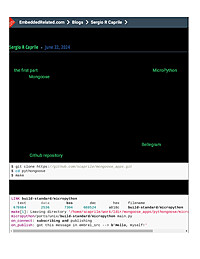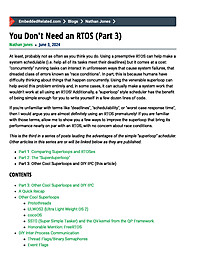
Here Comes The Noise!
Noise. That awful thing which nobody wants that most sadly never learn about. It's time to change that with this blog post.

You Don't Need an RTOS (Part 4)
In this fourth (and final!) article I'll share with you the last of the inter-process communication (IPC) methods I mentioned in Part 3: mailboxes/queues, counting semaphores, the Observer pattern, and something I'm calling a "marquee". When we're done, we'll have created the scaffolding for tasks to interact in all sorts of different the ways. Additionally, I'll share with you another alternative design for a non-preemptive scheduler called a dispatch queue that is simple to conceptualize and, like the time-triggered scheduler, can help you schedule some of your most difficult task sets.

7 Essential Steps for Reducing Power Consumption in Embedded Devices
Reducing the amount of power your embedded device is consuming is not trivial. With so many devices moving to battery operations today, maximizing battery life can be the difference between a happy, raving customer and an unhappy one that ruins your company's reputation. This post explores seven steps for optimizing your embedded systems' power consumption. You'll gain insights into the steps and techniques necessary along with receiving a few resources to help you on your journey.

Parlez vous Fortran?
A look at the variety of programming languages that are [or have been] used for embedded and some thoughts on the future possibilities.

Lost Secrets of the H-Bridge, Part V: Gate Drives for Dummies
Learn the most important issues in power MOSFET and IGBT gate drives: - Transistor behavior during switching - Calculating turn-on and turn-off times - Passive components used between gate drive IC and transistor - Reverse recovery - Capacitively-coupled spurious turn-on - Factors that influence a good choice of turn-on and turn-off times - Gate drive supply voltage management - Bootstrap gate drives - Design issues impacting reliability

When a Mongoose met a MicroPython, part II
In the first part of this blog, we introduced this little framework to integrate MicroPython and Cesanta's Mongoose; where Mongoose runs when called by MicroPython and is able to run Python functions as callbacks for the events you decide in your event handler. Now we add MQTT to the equation, so we can subscribe to topics and publish messages right from MicroPython.

ANCS and HID: Controlling Your iPhone From Zephyr
In this blog post, we see how certain BLE services can be used to control an iPhone from a Nordic nRF52840 using The Zephyr Project. Specifically, we see how to control certain multimedia functionality using the HID service. Finally, we learn how to use the ANCS client library provided by Nordic in The Zephyr Project to accept or decline an incoming call.

You Don't Need an RTOS (Part 3)
In this third article I'll share with you a few cooperative schedulers (with a mix of both free and commercial licenses) that implement a few of the OS primitives that the "Superduperloop" is currently missing, possibly giving you a ready-to-go solution for your system. On the other hand, I don't think it's all that hard to add thread flags, binary and counting semaphores, event flags, mailboxes/queues, a simple Observer pattern, and something I call a "marquee" to the "Superduperloop"; I'll show you how to do that in the second half of this article and the next. Although it will take a little more work than just using one of the projects above, it will give you the maximum amount of control over your system and it will let you write tasks in ways you could only dream of using an RTOS or other off-the-shelf system.

Lost Secrets of the H-Bridge, Part V: Gate Drives for Dummies
Learn the most important issues in power MOSFET and IGBT gate drives: - Transistor behavior during switching - Calculating turn-on and turn-off times - Passive components used between gate drive IC and transistor - Reverse recovery - Capacitively-coupled spurious turn-on - Factors that influence a good choice of turn-on and turn-off times - Gate drive supply voltage management - Bootstrap gate drives - Design issues impacting reliability

7 Essential Steps for Reducing Power Consumption in Embedded Devices
Reducing the amount of power your embedded device is consuming is not trivial. With so many devices moving to battery operations today, maximizing battery life can be the difference between a happy, raving customer and an unhappy one that ruins your company's reputation. This post explores seven steps for optimizing your embedded systems' power consumption. You'll gain insights into the steps and techniques necessary along with receiving a few resources to help you on your journey.

You Don't Need an RTOS (Part 4)
In this fourth (and final!) article I'll share with you the last of the inter-process communication (IPC) methods I mentioned in Part 3: mailboxes/queues, counting semaphores, the Observer pattern, and something I'm calling a "marquee". When we're done, we'll have created the scaffolding for tasks to interact in all sorts of different the ways. Additionally, I'll share with you another alternative design for a non-preemptive scheduler called a dispatch queue that is simple to conceptualize and, like the time-triggered scheduler, can help you schedule some of your most difficult task sets.

You Don't Need an RTOS (Part 1)
In this first article, we'll compare our two contenders, the superloop and the RTOS. We'll define a few terms that help us describe exactly what functions a scheduler does and why an RTOS can help make certain systems work that wouldn't with a superloop. By the end of this article, you'll be able to: - Measure or calculate the deadlines, periods, and worst-case execution times for each task in your system, - Determine, using either a response-time analysis or a utilization test, if that set of tasks is schedulable using either a superloop or an RTOS, and - Assign RTOS task priorities optimally.

You Don't Need an RTOS (Part 3)
In this third article I'll share with you a few cooperative schedulers (with a mix of both free and commercial licenses) that implement a few of the OS primitives that the "Superduperloop" is currently missing, possibly giving you a ready-to-go solution for your system. On the other hand, I don't think it's all that hard to add thread flags, binary and counting semaphores, event flags, mailboxes/queues, a simple Observer pattern, and something I call a "marquee" to the "Superduperloop"; I'll show you how to do that in the second half of this article and the next. Although it will take a little more work than just using one of the projects above, it will give you the maximum amount of control over your system and it will let you write tasks in ways you could only dream of using an RTOS or other off-the-shelf system.

Here Comes The Noise!
Noise. That awful thing which nobody wants that most sadly never learn about. It's time to change that with this blog post.

You Don't Need an RTOS (Part 2)
In this second article, we'll tweak the simple superloop in three critical ways that will improve it's worst-case response time (WCRT) to be nearly as good as a preemptive RTOS ("real-time operating system"). We'll do this by adding task priorities, interrupts, and finite state machines. Additionally, we'll discuss how to incorporate a sleep mode when there's no work to be done and I'll also share with you a different variation on the superloop that can help schedule even the toughest of task sets.

How to Read a Power MOSFET Datasheet
One of my pet peeves is when my fellow engineers misinterpret component datasheets. This happened a few times recently in separate instances, all involving power MOSFETs. So it’s time for me to get on my soapbox. Listen up! I was going to post...

Cracking the (embedded) Coding Interview
You never forget the day you land your first job. The thrill of receiving that call from your recruiter to tell you that you bagged your dream role! The relief when you finally see the offer letter you’ve been working towards for...

Introduction to Microcontrollers - Beginnings
Welcome to this Introduction to Microcontroller Programming tutorial series. If you are looking to learn the basics of embedded programming for microcontrollers (and a bit of embedded hardware design as well), I hope these tutorials will help you...





















